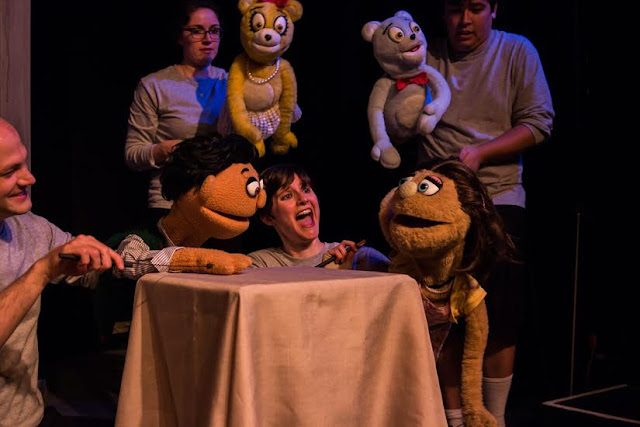Bite Me
by
Michael Dresdner
L to R: Garrett, Christopher photos by Dennis K Photography
Dracula
has arrived at Tacoma Little Theatre with all the sturm und drang its devoted
fans could desire. This script, penned by Stephen Dietz and directed by pug Bujeaud,
is far closer to the original Bram Stoker book than most, and should appeal to
both modernists and purists. This is a challenging version indeed, and as luck
would have it, there’s a top-to-bottom superb cast to make it happen.
L to R: Garrett, Morrow
At the
outset we eavesdrop on the naïve confidences of two sweet young women, Lucy
(Brynn Garrett) and Mina (Jesse Morrow) who will soon be forced to shed their
innocence as they either succumb to, or overcome, the insidious influence of
Dracula (Michael Christopher.) The same will be demanded of the gormless Harker
(Jacob Tice.) Sent to Transylvania to sell British land to Dracula, he’ll soon
be forced to find the steel to become a protector of his true love and a hunter
of evil. For his part, Dracula quickly sheds his civilized veneer when first
dealing with Harker, and soon shows his true colors, displaying all the
bravado, cape waving, and Jedi-like control powers we’ve come to expect.
Brian Wayne Jansen
Brian
Wayne Jansen, who plays the insane Renfield, goes from chillingly cool prologue
and wrap up narrator to the tortured, demented soul under Dracula’s control in a
role that is very physically demanding, to say the least. He’s not the only
one. Even though they often appear while other onstage action tries to draw
your eye, make sure you watch the cavorting of the two vixens (Ariel Birks and
Kadi Burt) who creep and crawl as sinuously as slithering quicksilver while
they torment Renfield, Harker, and others.
When
first Lucy and then Mina start showing unexplained illness, weakness, and odd behaviors,
Seward (Christopher Rocco), a doctor at the asylum where Renfield is being held
and an ardent adorer of Lucy, calls on Van Helsing (Joseph Grant) for help.
Along with Harker, they try to fight back against the sweeping tide of human destruction
led by Dracula.
L to R: Rocco, Grant
Clearly,
this is a very stark, black and white allegory. Darkness and night cloak evil
and destruction, while daylight, in the form of the trappings and beliefs of
the Catholic church, represent good and salvation. The bombastic, earnestly
devout Van Helsing freely wields not only garlic, but crucifixes, rosaries, and
communion wafers as his weapons of war. He slowly convinces the others that these,
along with religious invocations, are the only tools that will defend against
this incarnation of Lucifer.
That
same harsh rigidity is reflected in the excellent set by Blake R. York. With the
exception of a few columns for solemnity, everything from the stage levels and background
windows to the crypts and beds is naught but straight lines and hard edges.
Even the curved stairs are not smooth bends, but angled facets. Costumes
(Michele Graves) and set dressing (Jeffery Weaver) sometimes add a note of
color, but on the whole, they help reinforce the dark/light theme.
When it
comes to tech, though, the biggest bow goes to lighting designer Niclas R.
Olson, whose complex and dramatic lighting changes clearly delineated not only
times and locations, but moods and intentions as well. Kudos are indeed in
order. And because the lighting, sound effects (Dylan Twiner), and stage
changes are so complex and necessary, a special call out must go to the two
women who made all of that unfold flawlessly, stage manager Nena Curley and her
ASM Noelle Shai Edlin.
If you
are a fan of this genre, and I understand that most people these days are, this
is one version of this oft told story that you really should see. Favorite
versions aside, this impressively ambitious presentation is bound to evoke both
strong reactions and deep admiration for the crew that created it. Well done,
my friends, well done.
Dracula
Oct. 21
to Nov. 6, 2016
Tacoma
Little Theatre









































